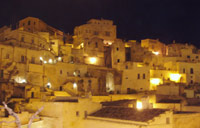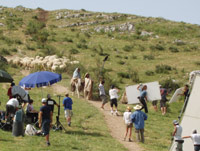Away in a manger in an ancient village in southern Italy, the cattle aren’t lowing, but the snakes, unfortunately, are hissing.

I’m in the heart of Bethlehem—OK, it’s actually a movie set near Matera, Italy—and I’m standing in front of an empty stable that will serve as the real-live manger scene for The Nativity Story, an upcoming film about Joseph and Mary and the birth of Christ. Currently being shot in Matera—and later in Morocco—the New Line Cinema production will release worldwide on December 1.
The typical nativity creatures are kept nearby for filming the defining moment—cattle, an ox, some sheep, a donkey … pretty much what you’d expect.
But as we’re gazing into the now-empty stable, an uninvited guest makes a cameo appearance: A five-foot long black snake slithers past the straw-filled trough which, just a few hours later, will hold a three-week-old boy, a local Italian infant as the baby Jesus. Crew members and set designers scurry away; some say the serpent is harmless, others, standing further back, aren’t so sure.
“Whatever you do,” yells one, “don’t tell Keisha! She’s terrified of snakes.”
Keisha Castle-Hughes, a former Oscar nominee, is the 16-year-old New Zealander playing the role of Mary. But at the moment, she’s a few miles away on a donkey, filming a scene on the road to Bethlehem with Miami’s Oscar Isaac, who plays Joseph.
We all agree: Mum’s the word. Keisha will never hear a peep.

Director Catherine Hardwicke (Thirteen, Lords of Dogtown) wouldn’t want to know about the snake, either. She’s already had a few uncooperative animals on the set—sheep running astray in the hills, magi-carrying camels refusing to walk down the street (while 200 extras waited for the cameras to roll), and at least one donkey that brought his own, er, “gift” to the stable where the babe lay in swaddling clothes.
While shooting segments of the manger scene the night before, Hardwicke said all of the animals were on their best behavior for one particularly perfect take—docile, photogenic, even seemingly watching the baby in the manger.
“It was one of those beautiful moments,” says Hardwicke. “And then, five seconds after I said, ‘Cut!’, the donkey gets up and takes a dump.”
Jerusalem, Italy?
I was one of several Christian journalists invited by New Line to spend a recent day on the set of The Nativity Story. After flying into Rome, we took a short flight to Bari and then a one-hour drive into Matera, nestled in the hilly arch of Italy’s “boot.”
Founded by the Romans in the third century B.C., Matera is home to ancient cave dwellings believed to have housed Italy’s first humans some 4,000 years ago. Some of the more “modern” buildings include a 13th-century cathedral, high on a hill in the middle of town. Matera so resembles ancient Palestine and Israel that other Bible movies have been filmed in the same location—Pasolini’s The Gospel According to Matthew in 1964, and Mel Gibson’s The Passion of The Christ in 2004.
“The joke is that Matera looks more like Jerusalem than Jerusalem does,” says R.J. Millard, New Line’s marketing consultant.

Indeed, old-town Matera does have that “Bible times” look, as do two major sets—Bethlehem and Nazareth—that New Line built in the surrounding countryside. We took a stroll through both sets (while filming was occurring elsewhere), visiting the Bethlehem stable where Christ would be born (preferably without a slinking serpent), and the Nazareth home where Mary grew up. There’s a fake olive tree in Nazareth that was also used in The Passion of The Christ.
Both sets transported us back 2,000 years; it seemed as if we were visiting the real deal.
It’s the kind of authenticity that screenwriter Mike Rich (Finding Forrester, Radio, The Rookie), our host for the day, strove for when he decided to write the story in late 2004, after Time and Newsweek simultaneously ran cover stories on the Nativity.

“My father had passed away recently,” says Rich, “and I was looking for something deeper to write—something that would take me into a new area other than sports.”
He’d found it. Rich, a devout Christian, spent the next 11 months researching the story, studying not only the Gospel accounts, but reading books and consulting with scholars. He sat down on December 1, 2005, to start writing, and less than a month later, he had a finished screenplay—practically record time for a film script.
On the fast track
then things really sped up. Within weeks, co-producer Wyck Godfrey (Flight of the Phoenix, Daddy Day Care, I Robot)—Rich’s friend and also a Christian—was pitching the script to New Line founder Bob Shaye, who was sold right away. Shortly after that, the script ended up in Hardwicke’s hands.
She loved it and signed on, and New Line put the project on the fast track—the first major theatrical release about a biblical story from a Hollywood studio since the 1950s heyday of Bible epics (Ben-Hur, The Ten Commandments, The Robe). It will open worldwide exactly one year to the day after Rich started writing—that’s light speed in the world of filmmaking.
In January, Hardwicke had a stack of scripts on her desk, and she was trying to determine what film she’d like to do next. When she spotted Rich’s script, she moved it to the top of the pile.
“The title caught my eye, so I decided to read that one first,” she says. “I was amazed at how good it was. I remember thinking, This can’t be that interesting. I had read the story in the Bible so many times, and the characters were so iconic. But Mike had gotten so inside the characters: ‘What would it be like to be those people?'”
That’s exactly what Rich was aiming for.
“The nativity is usually presented as an event-board story—this happened, then this happened, then this happened,” he says. “It’s rarely presented as a character story. That’s how I wanted to do it.”
Human characters
I’ve read Rich’s script, and it’s faithful and reverent to the Gospel accounts, but also brings Joseph and Mary’s characters alive in a very human way. They wrestle with fears and doubts and anxieties, all within the framework of unshakeable faith.
We meet their parents and families, even before they’re betrothed to one another. We’re there for the awkward moment when Mary’s father tells his daughter that she will be Joseph’s wife. We’re there for Gabriel’s visit, for Joseph’s dream, for the journey to Bethlehem—and the gamut of emotions that each experiences, every step of the way.
We get to know Elizabeth and Zechariah. We hit the road with the three wise men—Balthasar, Gaspar, and Melchior. We meet shepherds, tending their flocks by night. We go into Herod’s palace and see what a despicable, paranoid man he really is.

There are playful, humorous moments. There are tension-filled scenes. And there is love, especially as shown on the arduous trek to Bethlehem, in which Joseph’s tender care for his betrothed begins to shine as brightly as a certain star that has appeared on the horizon.
It’s a Bible story. But it’s a human story too.
“When you grow up in church, it becomes an objectified story,” says Godfrey, the co-producer. “It’s never told from Joseph and Mary’s perspective; it’s a story told without much conflict.
“But what would it be like to be 14 years old and go through what she went through? What would it be like to be a man and have your betrothed come to you and say she’s pregnant—not by another man, but as an act of God?”
Co-producer Marty Bowen also loves the way the characters have come to life.
“Growing up Catholic, I’ve always put Mary on a pedestal,” he says. “She was beyond reproach, and we never took her off that pedestal. When you see a statue of Mary in a church, she’s not real; she’s plaster. We’re trying to make her real.
“We want to portray her as a fairly normal girl becoming a young woman. We grow with her in this story; it’s an extreme character arc. That’s what I hope Catholics get out of this—to see Mary as a girl, not just a woman you can’t relate to. And Catherine has done a good job making her identifiable.”
As Bowen speaks, Castle-Hughes is sitting sideways on a donkey a couple hundred yards away, a pillow under her clothing to make her look quite pregnant. Isaac, playing Joseph, is leading the donkey down a hill as sheep walk across the path in front of them; an old shepherd looks on.
Bowen watches the scene unfold, and then he breaks into a mischievous grin: “As for me, I get Mary in a headlock every once in a while and tell her not to drink so many Cokes in a day.”
Not a typical teen
Castle-Hughes, who just turned 16 before filming began, might have a thing for Cokes, but she’s also got a thing for this role. “She’s taking it incredibly seriously,” says Rich. “She’s quiet, reserved, and mature beyond her years. She’s not the type to run off to the mall, like other teenagers.”
“At some points,” adds Bowen, “she seems like a regular teenager. But at other points, she seems like a mature young woman. The gravity of what she’s doing is coming to her more and more every day.”
The young Kiwi says she feels the weight of responsibility in playing this role.

“When I got the part, it didn’t hit me at first,” says Castle-Hughes, nominated for an Academy Award for Best Actress at age 12 for her role in Whale Rider, one of 2003’s best films. “But on the plane over here, I was writing in my diary, and then it hit me: Ohhh! I’m playing Mary!
“The biggest thing, you never think that she was just 14 and carrying a child. She was just a girl, and then the next day, she’s a woman and married, and the next she becomes like the mother of the world.”
Castle-Hughes, who says she adheres to “no particular religion,” says she has received some good tips from her mother about what it’s like to carry a child within.
“My mum’s 8½ months pregnant right now,” she says, “so she’s going through exactly what my character is going through. She’s giving me great advice.” Castle-Hughes, who’d endured 90-plus-degree heat for that day’s filming, laughs and adds, “All I know is that after this, I’m never having a child!”
Still, she says she likes “the way the story is told from a human point of view.” Her co-star, the 26-year-old Oscar Isaac, agrees.
“In past films,” he says, “the story has felt very ‘representational’—they were walking icons. For me, it was very important to learn as much as possible about what these people were like and how they lived, so that when we played the parts, the characters would be as authentic as possible.”
Nazareth comes alive
To capture that authenticity, New Line contracted several workers from Nazareth Village—a tourist attraction (“the Nazareth Jesus knew,” according to its website)—to teach the cast how Nazarenes might have lived 2,000 years ago. They were taught how to use certain tools, how to build homes, how to press olives and grapes, how to make bread, how to make cheese, how to milk goats.
“Keisha is one of the very best goat milkers out here,” says Bowen with a wink. “I think it’s all in the looseness of the wrist.”
Castle-Hughes says her friends back home in New Zealand would get a kick out of that, “because I’m not a huge animal fan.”
So, she rides a whale in her first film, and rides a donkey—and milks a goat—in this one. Perhaps she might become an animal fan after all.
That is, as long as she doesn’t run into any five-foot black snakes.
Keep watching Christianity Today Movies for more coverage of The Nativity Story—including interviews with screenwriter Mike Rich, plus various cast and filmmakers—in the months ahead.
Copyright © 2006 Christianity Today. Click for reprint information.














